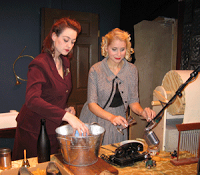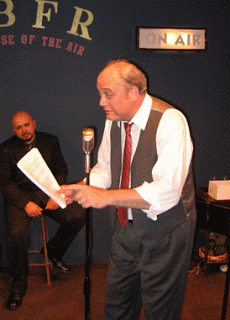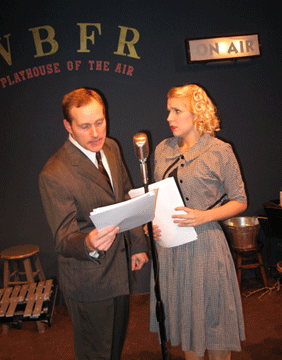Review: It's A Wonderful Life, a Live Radio Play by Austin Playhouse
by Michael Meigs
Here’s a warm, vivid and imaginative presentation that’s a time machine back to simpler pleasures.
As part of the audience for a 1946 radio presentation of It’s A Wonderful Life, you enjoy the magic of radio drama. Five actors do double duty – as multivoiced interpreters for that imaginary radio audience out there, and as an ensemble of 5 radio pros working a script in front of you. Yes, they're holding scripts -- but under Lara Toner's direction they are moving and interpreting the story with the grace and timing of aerial artists.
It’s a fine holiday presentation – one that won’t scoff at the season, distort it with eccentric characters, or push any agenda other than the American Dream.
An avowal -- I’m as much a fool for old-fashioned Christmas stories as the next person. For example, I own four media versions of Dickens’ Christmas Carol – a film with George C. Scott as Scrooge, the 1940s black-and-white British version featuring Alastair Sim, and radio theatre versions with Lionel Barrymore and with Patrick Stewart.

Playwright Joe Landry has worked a clever transformation with Frank Capra’s 1947 film starring Jimmy Stewart as the earnest George Bailey, driven by desperation to contemplate suicide on Christmas Eve so his life insurance can pay off the debts of his family-owned savings and loan. That black-and-white Christmas fantasy also starred Donna Reed and Lionel Barrymore.
The Internet Movie Database says that this was the first and last time that Capra produced, financed, directed and co-wrote one of his films – and that it was Capra’s favorite. Unfortunately for them, Capra and his successors allowed copyright to lapse on this classic, which meant that Landry could appropriate the plot and could use the dialogue verbatim in his re-working of this Christmas myth.
Shorter, authorized radio versions were aired in 1947 and 1948, but this one runs a full, satisfying two hours, intermission included.
Assuming that you’ve seen the film, as a spectator at Austin Playhouse’s Larry L. King Theatre you can experience the story on several levels simultaneously. (If you haven’t seen the movie, the Paramount Theatre in Austin is showing it on December 7, 9 and 12, and you can certainly find it at the video shops or from Netflix. You could even read Landry’s version on-line.) Most immediately at the Larry L. King theatre, you enjoy seeing and participating while those accomplished actors in their fashionable 1940’s get-ups create the story, complete with sound effects. They do voices for a whole town plus a couple of angels.
Most immediately at the Larry L. King theatre, you enjoy seeing and participating while those accomplished actors in their fashionable 1940’s get-ups create the story, complete with sound effects. They do voices for a whole town plus a couple of angels.
When earnest George Bailey contemplates suicide, his quirky guardian angel works the magic of showing him what his hometown Bedford Falls would have been, had he never been born. The scene is bleak and barren, reminding our hero that his life to date has not been useless and others depend upon his continued existence.
 You’ll grin when Ben Wolfe (left, in background) morphs from quavering Angel Second Class Clarence Oddbody to the exuberant immigrant Mr. Martini to George’s youngest son. Wolfe has twelve assigned roles plus participation in crowd scenes. The dapper Dirk Van Allen as principal announcer Freddie Fillmore is almost as busy. Michael Stuart (right) as Emory Lake has the Barrymore role of the wicked old Mr. Potter plus the Irish policeman and others speaking in distinctive dialects.
You’ll grin when Ben Wolfe (left, in background) morphs from quavering Angel Second Class Clarence Oddbody to the exuberant immigrant Mr. Martini to George’s youngest son. Wolfe has twelve assigned roles plus participation in crowd scenes. The dapper Dirk Van Allen as principal announcer Freddie Fillmore is almost as busy. Michael Stuart (right) as Emory Lake has the Barrymore role of the wicked old Mr. Potter plus the Irish policeman and others speaking in distinctive dialects.
The radio play in your ears is engrossing throughout, even though you probably know the outcome (after all, myths are usually not mysteries – repetition has made them beloved folklore). And that story mixes agreeably in your mind’s eye with images from the Capra classic.
The cast plays their 1946 presentation with not a whisper of irony, putting us back into the determined, hopeful postwar days when the United States had prevailed over real evil through right thinking, just action, and mobilization of small town virtue. That was 72 years ago – when my father was about the age that my daughter is, today. 
Benjamin Summers as George Bailey (left) is frank and emotive; his straightforward interpretation overshadows Jimmy Stewart for us. Molly Karrasch Wineberg (right) is attractive and virtuous as George’s wife Mary, qualities inevitably required in that America. Rachel Dendy calmly and adroitly embodies a whole crowd, from Ma Bailey to her grand daughter, George’s plaintive young daughter Zuzu Bailey.
The King theatre is a small one, with only about fifty seats, and It’s A Wonderful Life runs for only eleven performances. Sign up as a member of that 1946 radio audience – you’ll find that the evening provides a great antidote to the pressures and uncertainties of the 2008 holiday season and the 2008-2009 interregnum.
Click for Robert Faires' review in the Austin Chronicle, December 18
Hit as of 2015 03 01: 3629
It's A Wonderful Life, a Live Radio Play
by Joe Landry
Austin Playhouse
